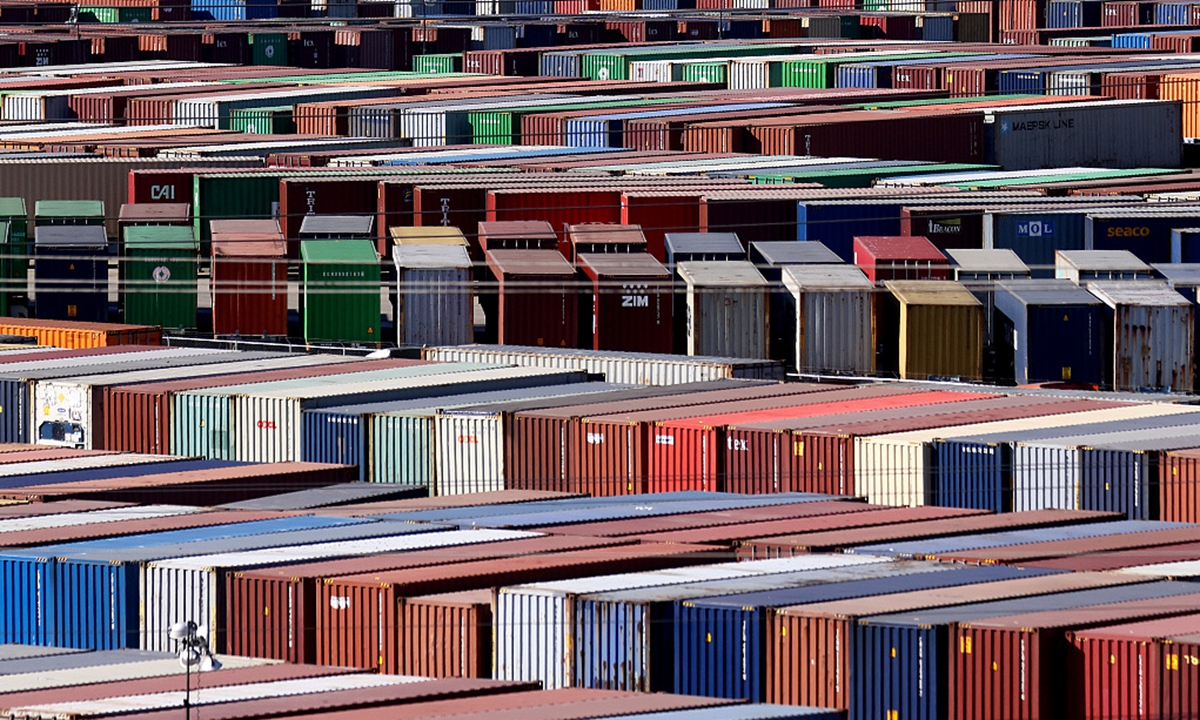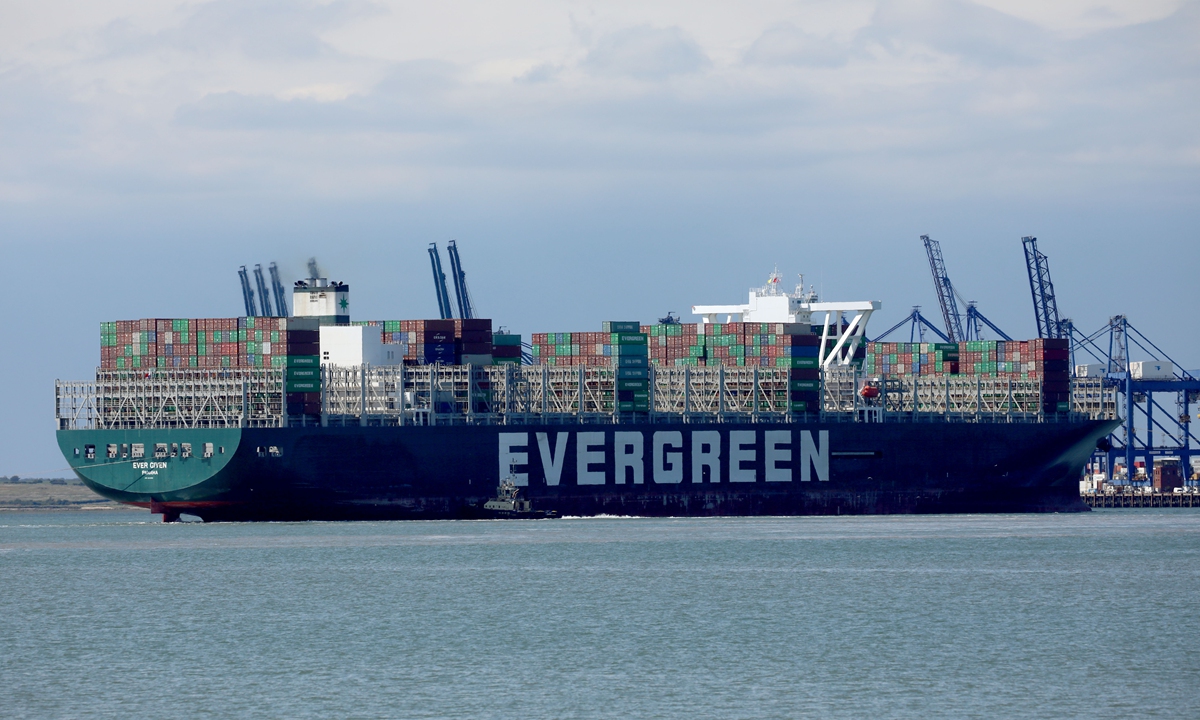
Photo: CFP
As the global shipping industry has become increasingly integrated, any disruption can have profound ripple effect. Although the outlook for global shipping industry next year is not optimistic, China, the largest stabilizer in the world's trade over the past two years, will remain stable.
Market insiders predict that the snarls now plaguing global shipping sector will not end in 2022, and that US ports backlog may become even more severe, with no end in sight.
If the US port chaos is not resolved or significantly eased in the two months after the Chinese New Year in 2022, or by the next peak trade season which arrives in second half of the year, US port congestion may become more serious, and it will not be fundamentally alleviated any time soon, Han Jun, an analyst from China Securities told the Global Times.
The probability of global shipping returning to 2019 levels before the eruption of the pandemic, is considered to be extremely low across the industry, Han said.
Zhong Zhechao, founder of One Shipping, said that the global supply chain remains under considerable strain, and the industry's pessimistic expectations for cross-ocean shipping will extend well into 2022, or even 2023.
"Freight fees will remain elevated next year," Zhong told the Global Times on Sunday, adding that Chinese export-oriented companies need to be prepared for the surging costs as well as mounting uncertainties as the pandemic could pose threat at any time to the supply chain.
Compared with high value-added products, the labor-intensive products like furniture might be affected in terms of volume next year due to the high freight charges, Zhong said.
"But overall, we could see China's export prospective remain positive next year," he added.
Hu Yifan, chief China economist at UBS, said in a recent briefing that China's exports have demonstrated robust resilience over the past two years. Despite the fact that growth momentum might slow down in 2022, it still will remain strong among major economies in the world.
China's foreign trade expanded 7.8 percent year-on-year last month, with exports jumping 14.9 percent on a yearly basis in yuan terms, data from the General Administration of Customs showed.
Global shipping suffered in 2021, with the Suez Canal blocked in March, followed by two major ports of South China's Shenzhen and East China's Ningbo partially shut down due to localized COVID-19 flare-ups in May and August, respectively, which was later exacerbated by US port congestion which began to escalate in July.
Consumers across the globe have felt the negative impact of shipping snarls as well as sharp price increase of shipped products. "If the buyer does not share these costs, we will lose money, then we can only cancel the order, otherwise the more exports we did, the more we lose," Zhang Shuang, from Yiwu, one of the world's largest small commodity trading hubs in East China's Zhejiang Province, told the Global Times.

The container ship Ever Given arrives at Felixstowe port on August 3, 2021 in England. The container ship had become lodged in the canal in March, requiring a six-day salvage operation to free the vessel. File Photo: VCG
Rising demand for Chinese goodsThe head of a shipping agency surnamed Yang told the Global Times that although the pandemic has kept spreading in 2021 and the efficiency of international transportation capacity is declining, trade volume between China and the US is still growing, placing pressure on already stretched container management.
"I have been rushing to snap up containers for months, otherwise the goods parked in the warehouse will not be able to be packaged and shipped out," he said.
The chaos across global shipping industry has also directly affected the global production.
Market insiders told the Global Times that the price of global fertilizer rose sharply in 2021, especially nitrogen fertilizers. One of the key reasons is the Panamanian-flagged vessel Ever Given becoming stuck in Suez Canal in March, impacting shipping for natural gas, raw material for global nitrogen fertilizer production, and sharply pushing up prices.
COVID-19 breakouts and typhoons also severely affected outbound cargo transportation capacity for two of China's most important ports
- Shenzhen and Ningbo in 2021.
From the Port of Ningbo, it is usually possible for a departing vessel to reach the US West Coast in less than a dozen days, but given the current logjam, unloading a ship can take up to 10 days.
Because of the pandemic, the US' dependence on Chinese goods has increased and strong demand has caused a larger volume of Chinese goods to be shipped to the US, quickly.
Yang told the Global Times that the demand for Chinese goods in the US has risen sharply during the pandemic, especially common household items. Data from Chinese customs showed that over the first 11 months of this year, China's exports to the US increased by 28.3 percent, exceeding the total value of imports and exports for the entirety of 2020.
Recently in November, the US surpassed ASEAN and the EU to become China's largest export destination.
The arrival of large quantity of cargo being warehoused at US western coastal ports poses a severe test for processing capabilities of port operators and logistics firms, creating a situation in which docks and container facilities are overflowing while supermarket shelves, in contrast, are often bereft of essential goods. As a remedy, the US government has forced major ports to extend operations to 24 hours a day.
Transporting goods from the waterfront to shops or inland warehouses has also become a significant challenge in the US.
An analyst named Wu Yifan from Huachuang Securities said that the transportation conundrum in the US has now extended from the front-end terminal to the back-end, with a critical labor shortage placing significant pressure on each link in the logistical chain, including setting collection and delivery timetables.





